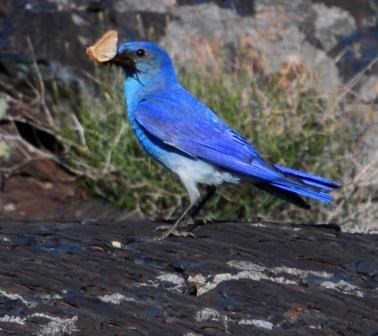
Doug Owen Sialia currucoidesDescription
HabitatMountain bluebirds are one of the most conspicuous birds around Craters of the Moon's Loop Road. The only bluebird normally found above 5000 feet in elevation, the mountain bluebird is common throughout the northern portions of Craters of the Moon from March – October. BehaviorDuring the summer months, mountain bluebirds feed primarily on insects. They forage by perching on shrubs or tall grasses and often hover before catching prey on the ground or in mid-air. During the spring and early summer, look for them feeding on tent caterpillars on shrubs. Like robins and other thrushes, they will eat berries and small fruits when available. Why Do Bluebirds Come to Craters?Research in the 1980s found that mountain bluebirds were most abundant in the lava fields at Craters of the Moon and around the volcanoes in the Cascade Mountains. As it turns out, bluebirds don't have to nest in trees! Any hole or closed-in space that is big enough and has an entrance the right size (about 1 ½ to 2 inches) can be used. The lava fields at Craters of the Moon have an abundance of crevices and pockets that are just the right size for nesting bluebirds. This means that the availability of roosting and nesting sites does not limit the number of bluebirds, as it does in most of North America. What limits the number of bluebirds here is the availability of insects to eat and their willingness to tolerate each other. This adds up to bluebirds being one the most commonly-seen birds at Craters of the Moon. When driving the Loop Road or walking a trail, watch for a flash of blue against the black lava as a mountain bluebird flies by. |
Last updated: July 31, 2020
